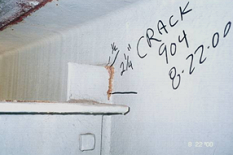Background
 Fatigue-induced cracking is a common failure mode in many steel bridges reaching their original design life. These aging bridge structures have experienced increasing traffic volume and weight, deteriorating components as well as a large number of stress cycles. There are a number of cases reported that involve fatigue damage in highway bridges. For example: Fatigue-induced cracking is a common failure mode in many steel bridges reaching their original design life. These aging bridge structures have experienced increasing traffic volume and weight, deteriorating components as well as a large number of stress cycles. There are a number of cases reported that involve fatigue damage in highway bridges. For example:
- Cracks resulting from the typical web gap distortion near the bottom flange of welded plate girders were reported in the US 13 bridge (a steel I-girder bridge) over Pocomoke River, Maryland. The distortion induced stresses have initiated horizontal cracks in the web-to-flange welds and propagated into vertical cracks at the end of the web-to-connection plate welds.
- On March 14 2003, two large cracks were discovered in the webs of two steel girders on the I-895 Bridge over U.S. Route 1 and the Patapsco River in Elkridge, Maryland. The fracture originated at the top of the web-to-stiffener weld. One crack propagated downward and diagonally, fractured the full height of the 90-inch web plate.
- Last year, fatigue cracking induced damages to the eye-bars of the existing San Francisco Bay Bridge led to pieces of steel plummeting onto the roadway during rush hour. Several steel repair parts fall on peak hour traffic as wind caused the bridge to vibrate and the traffic was stopped.
 Such incidences happen frequently without prior warnings. The recent Steel Bridge Testing Program (SBTP) supported by FHWA is aimed at evaluating and improving “off-the-shelf” NDT technologies capable of detecting surface and subsurface fatigue cracks in steel bridges. Such incidences happen frequently without prior warnings. The recent Steel Bridge Testing Program (SBTP) supported by FHWA is aimed at evaluating and improving “off-the-shelf” NDT technologies capable of detecting surface and subsurface fatigue cracks in steel bridges.
The investment of the United States in civil infrastructures is estimated to be $20 trillion. The magnitude of the societal challenges associated with infrastructures, especially with aging bridges, is daunting. The Commercial Remote Sensing and Spatial Information (CRS&SI) Technologies Program authorized in the Safe, Accountable, Flexible and Efficient Transportation Equity Act: A Legacy for Users (SAFETEA-LU) focuses on major national initiatives and validation of CRS&SI technology applications which deliver smarter and more efficient methods, processes and services for transportation infrastructure development and construction.
 Despite years of research in overcoming these challenges, catastrophic failures (e.g., the interstate 35W bridge collapse in Minneapolis, MN in 2007) still occur, which is mainly due to various difficulties in detecting bridge health conditions under highly uncertain operational conditions and also our limited understanding of the failure mechanisms in these systems. This proposal strives to address this issue by establishing an Integrated Structural Health Monitoring (ISHM) System for remote infrastructure sensing, diagnostics and prognosis The proposed ISHM will entail a few recent innovations that will transform the current state-of-the-practice in remote sensing and management of highway infrastructures: Despite years of research in overcoming these challenges, catastrophic failures (e.g., the interstate 35W bridge collapse in Minneapolis, MN in 2007) still occur, which is mainly due to various difficulties in detecting bridge health conditions under highly uncertain operational conditions and also our limited understanding of the failure mechanisms in these systems. This proposal strives to address this issue by establishing an Integrated Structural Health Monitoring (ISHM) System for remote infrastructure sensing, diagnostics and prognosis The proposed ISHM will entail a few recent innovations that will transform the current state-of-the-practice in remote sensing and management of highway infrastructures:
- interrogation of local small damages from wideband acoustic emission (AE) signals even in areas where traditional AE sensors cannot be placed due to geometry and structural constraints;
- smart wireless sensor networks that can self-power (wind or solar), self-calibrate, and automatically scan and diagnose interrogation data.
The proposed ISHM system offers a promising technology to revolutionize the inspection and SHM of civil infrastructures and will more accurately estimate the remaining service life at reduced life cycle costs.
|